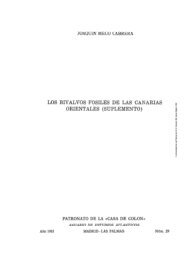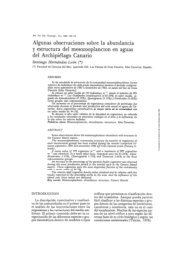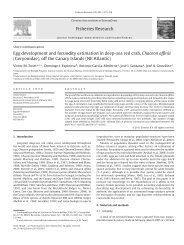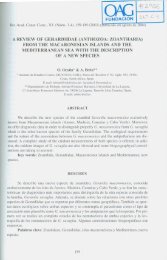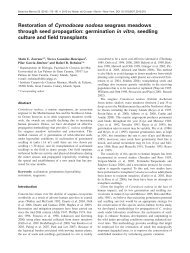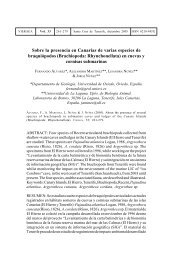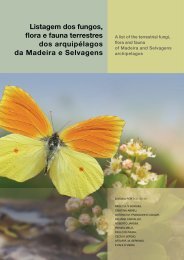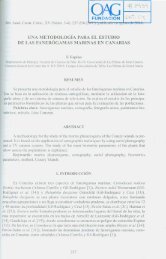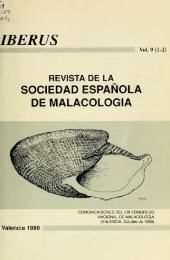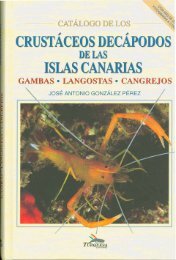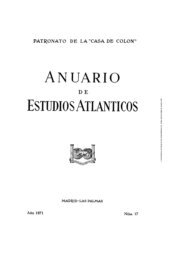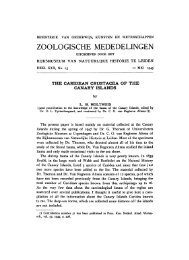Discoloraciones por acumulaciones de la diatomea ... - redmic
Discoloraciones por acumulaciones de la diatomea ... - redmic
Discoloraciones por acumulaciones de la diatomea ... - redmic
Create successful ePaper yourself
Turn your PDF publications into a flip-book with our unique Google optimized e-Paper software.
VIERAEA Vol. 33 51-58 Santa Cruz <strong>de</strong> Tenerife, diciembre 2005 ISSN 0210-945X<br />
<strong>Discoloraciones</strong> <strong>por</strong> <strong>acumu<strong>la</strong>ciones</strong> <strong>de</strong> <strong>la</strong> <strong>diatomea</strong><br />
bentónica epipsámica Attheya armatus<br />
(Centrales, Bacil<strong>la</strong>riophyta) en p<strong>la</strong>yas <strong>de</strong> arena <strong>de</strong>l<br />
S y SW <strong>de</strong> Gran Canaria (Canarias, España).<br />
ALICIA OJEDA RODRÍGUEZ & LEOPOLDO O’ SHANAHAN ROCA<br />
Instituto Canario <strong>de</strong> Ciencias Marinas. Dirección General <strong>de</strong><br />
Universida<strong>de</strong>s e Investigación. Consejería <strong>de</strong> Educación, Cultura y<br />
De<strong>por</strong>tes. Gobierno <strong>de</strong> Canarias. Apdo. 56 Tel<strong>de</strong>. 35200 Las Palmas.<br />
OJEDA, A. & L. O’ SHANAHAN. 2005. Discolorations of the surf zone diatom<br />
Attheya armatus (Centrales, Bacil<strong>la</strong>riophyta) on sandy beaches in Gran Canaria<br />
(Canary Is<strong>la</strong>nds, Spain). VIERAEA 33: 51-58.<br />
ABSTRACT: On the southern coast of Gran Canaria is<strong>la</strong>nd (27º 47’ N; 15º 43<br />
W) extensive discolorations of diatoms were observed in the surf zone of sandy<br />
beaches along a five years period (2000-2004). Attheya armatus (T. West)<br />
Crawford was the only species responsible of the discolorations. This is the<br />
lowest <strong>la</strong>titu<strong>de</strong> in the North Hemisphere in which Attheya armatus surf diatom<br />
accumu<strong>la</strong>tions has been re<strong>por</strong>ted and the first record of the occurrence of surf<br />
diatoms accumu<strong>la</strong>tions in the Canary Is<strong>la</strong>nds.<br />
Key words: Surf diatoms, Attheya armatus, first record of accumu<strong>la</strong>tions,<br />
Canary Is<strong>la</strong>nds.<br />
RESUMEN: Durante los años 2000 a 2004 hemos observado discoloraciones<br />
<strong>por</strong> <strong>acumu<strong>la</strong>ciones</strong> <strong>de</strong> <strong>diatomea</strong>s en <strong>la</strong> zona <strong>de</strong> rompiente <strong>de</strong> <strong>la</strong>s o<strong>la</strong>s en p<strong>la</strong>yas<br />
<strong>de</strong> arena <strong>de</strong>l sur y suroeste <strong>de</strong> <strong>la</strong> is<strong>la</strong> <strong>de</strong> Gran Canaria (27º 47’ N; 15º 43 W). La<br />
<strong>diatomea</strong> bentónica Attheya armatus (T. West) Crawford fue <strong>la</strong> única especie<br />
i<strong>de</strong>ntificada. Esta <strong>la</strong>titud es <strong>la</strong> más baja en el hemisferio norte en <strong>la</strong> que se han<br />
observado estas <strong>acumu<strong>la</strong>ciones</strong>, <strong>la</strong>s cuales se citan <strong>por</strong> primera vez en Canarias.<br />
Pa<strong>la</strong>bras c<strong>la</strong>ve: Diatomeas <strong>de</strong> rompientes <strong>de</strong> <strong>la</strong>s o<strong>la</strong>s, Attheya armatus, primera<br />
cita <strong>de</strong> <strong>acumu<strong>la</strong>ciones</strong>, Canarias.<br />
INTRODUCCIÓN<br />
El ecosistema <strong>de</strong> rompientes <strong>de</strong> <strong>la</strong>s o<strong>la</strong>s se <strong>de</strong>fine como <strong>la</strong> zona <strong>de</strong> p<strong>la</strong>ya comprendida<br />
entre el frente superior <strong>de</strong> <strong>la</strong>s o<strong>la</strong>s hasta <strong>la</strong> línea <strong>de</strong> rotura, mar a<strong>de</strong>ntro<br />
(Campbell & Bate, 1997). Las <strong>diatomea</strong>s <strong>de</strong> <strong>la</strong>s rompientes <strong>de</strong> <strong>la</strong>s o<strong>la</strong>s (“surf diatoms”)
52<br />
se caracterizan <strong>por</strong> su ten<strong>de</strong>ncia a formar discoloraciones producidas <strong>por</strong> <strong>de</strong>nsas<br />
<strong>acumu<strong>la</strong>ciones</strong> <strong>de</strong> célu<strong>la</strong>s, que le confieren al agua <strong>de</strong> mar y a <strong>la</strong> espuma <strong>de</strong> <strong>la</strong>s rompientes<br />
un característico color ver<strong>de</strong> oscuro o marrón (Gayoso & Muglia, 1991). Unas<br />
pocas especies <strong>de</strong> <strong>diatomea</strong>s han sido citadas como responsables <strong>de</strong> <strong>la</strong> formación <strong>de</strong><br />
estas <strong>acumu<strong>la</strong>ciones</strong> en p<strong>la</strong>yas <strong>de</strong> arena. Entre el<strong>la</strong>s <strong>de</strong>staca, Attheya armatus, especie<br />
bentónica epipsámica (Crawford et al., 2000). Estas <strong>acumu<strong>la</strong>ciones</strong> <strong>de</strong> <strong>diatomea</strong>s<br />
sólo se producen en p<strong>la</strong>yas <strong>de</strong> arena, lo que pue<strong>de</strong> ser <strong>de</strong>bido a su modo <strong>de</strong> vida<br />
epipsámico y a una hidrodinámica particu<strong>la</strong>r <strong>de</strong> <strong>la</strong>s rompientes. En general, se trata <strong>de</strong><br />
p<strong>la</strong>yas disipativas o intermedias, <strong>de</strong> pendiente suave, con amplias zonas <strong>de</strong> rompientes<br />
<strong>de</strong> alta o mediana energía, con aguas cálidas o temp<strong>la</strong>das y con arenas <strong>de</strong> grano<br />
fino (Gayoso & Muglia, 1991; Garver & Lewin, 1981). En <strong>la</strong>s <strong>acumu<strong>la</strong>ciones</strong>, <strong>la</strong>s<br />
<strong>diatomea</strong>s se adhieren a <strong>la</strong>s burbujas generadas <strong>por</strong> <strong>la</strong>s o<strong>la</strong>s y, posteriormente, se<br />
acumu<strong>la</strong>n en <strong>la</strong> superficie <strong>de</strong> <strong>la</strong> espuma, a consecuencia <strong>de</strong> <strong>la</strong>s revolturas, giros y<br />
<strong>de</strong>más movimientos <strong>de</strong>l agua <strong>de</strong> <strong>la</strong>s o<strong>la</strong>s en su discurrir <strong>por</strong> el intermareal (Lewin &<br />
Schaefer, 1983).<br />
Hasta el momento, sólo se han <strong>de</strong>scrito seis especies <strong>de</strong> <strong>diatomea</strong>s causantes <strong>de</strong><br />
<strong>la</strong> formación <strong>de</strong> discoloraciones (Du Preez & Campbell, 1997): Anaulus australis Drebes<br />
et Schulz; Asterionel<strong>la</strong> socialis Lewin et Norris, Asterionellopsis g<strong>la</strong>cialis<br />
(Castracane) Round; Au<strong>la</strong>codiscus kittonii Arnott; Au<strong>la</strong>codiscus africanus Cottam<br />
y Attheya armatus (T. West) Crawford.<br />
En este trabajo presentamos <strong>la</strong> <strong>de</strong>tección, <strong>por</strong> primera vez en p<strong>la</strong>yas <strong>de</strong> Canarias,<br />
<strong>de</strong> <strong>acumu<strong>la</strong>ciones</strong> <strong>de</strong> A. armatus, no sólo <strong>por</strong> el interés científico que ello conlleva<br />
sino <strong>por</strong>que <strong>la</strong>s <strong>acumu<strong>la</strong>ciones</strong> <strong>de</strong> <strong>diatomea</strong>s <strong>de</strong> rompientes, en <strong>la</strong>s p<strong>la</strong>yas <strong>de</strong> baño,<br />
pue<strong>de</strong>n ser muy l<strong>la</strong>mativas y <strong>de</strong>spiertan el interés y <strong>la</strong> preocupación pública, al atribuirse<br />
<strong>la</strong>s discoloraciones a contaminación <strong>por</strong> aguas residuales o, en otros casos, a<br />
manchas <strong>de</strong> grasa, lo cual ha sido recogido también <strong>por</strong> otros autores (Halcrow, 2000;<br />
Hewson et al., 2001; Du Preez & Campbell, 1997; Ifremer, 2003).<br />
Tab<strong>la</strong> I. Distribución tem<strong>por</strong>al <strong>de</strong> <strong>la</strong> presencia <strong>de</strong> <strong>acumu<strong>la</strong>ciones</strong> en p<strong>la</strong>yas arenosas <strong>de</strong>l S y<br />
SW <strong>de</strong> Gran Canaria (is<strong>la</strong>s Canarias).
MATERIAL Y MÉTODOS<br />
Las discoloraciones <strong>por</strong> <strong>acumu<strong>la</strong>ciones</strong> <strong>de</strong> A. armatus han sido estudiadas, durante<br />
los años 2000 al 2004, en p<strong>la</strong>yas <strong>de</strong>l S y SW <strong>de</strong> Gran Canaria: Taurito (municipio<br />
<strong>de</strong> Mogán), Meloneras, Las Burras y San Agustín (municipio <strong>de</strong> San Bartolomé <strong>de</strong><br />
Tirajana), <strong>la</strong>s cuales presentan <strong>la</strong>s características físicas <strong>de</strong>scritas en el apartado <strong>de</strong><br />
Introducción, necesarias para <strong>la</strong> formación <strong>de</strong> <strong>acumu<strong>la</strong>ciones</strong>.<br />
Las muestras se tomaron directamente <strong>de</strong> <strong>la</strong>s <strong>acumu<strong>la</strong>ciones</strong> cuando se <strong>de</strong>tectaron<br />
indicadores visuales <strong>de</strong> <strong>la</strong>s mismas, es <strong>de</strong>cir, aglomeraciones masivas <strong>de</strong> color<br />
marrón verdoso sobrenadando en <strong>la</strong> espuma <strong>de</strong>l frente <strong>de</strong> <strong>la</strong>s o<strong>la</strong>s, o manchas <strong>de</strong>positadas<br />
sobre <strong>la</strong> arena al retirarse <strong>la</strong> marea. En <strong>la</strong> Tab<strong>la</strong> I se <strong>de</strong>tal<strong>la</strong>n los muestreos<br />
realizados.<br />
La toma <strong>de</strong> muestras se realizó en bajamar, alre<strong>de</strong>dor <strong>de</strong>l mediodía, ya que <strong>la</strong>s<br />
<strong>acumu<strong>la</strong>ciones</strong> comenzaban a formarse en <strong>la</strong>s primeras horas <strong>de</strong>l día, alcanzando su<br />
máximo apogeo al mediodía. Por <strong>la</strong> tar<strong>de</strong> comenzaban a <strong>de</strong>svanecerse, <strong>de</strong>sapareciendo,<br />
finalmente, <strong>por</strong> <strong>la</strong> noche, lo que coinci<strong>de</strong> con <strong>la</strong>s observaciones <strong>de</strong> Du Preez &<br />
Campbell (1997). Se tomaron y estudiaron un total <strong>de</strong> doce muestras.<br />
La <strong>de</strong>terminación taxonómica se ha basado en los trabajos <strong>de</strong> Round et al.<br />
(1990) y Crawford et al. (1994). Se utilizó un microscopio óptico OLYMPUS BX41 a<br />
600X y 1000X. Para observar los <strong>de</strong>talles <strong>de</strong>l frústulo se realizó una limpieza con<br />
peróxido <strong>de</strong> hidrógeno concentrado para eliminar <strong>la</strong> materia orgánica. Se obtuvieron<br />
imágenes con una cámara digital Olympus Camedia adaptada al microscopio. Los<br />
datos biométricos se obtuvieron <strong>de</strong> preparaciones analizadas en un microscopio invertido<br />
Zeiss que dispone <strong>de</strong> un “software” para análisis <strong>de</strong> <strong>la</strong> imagen (Microimage) y<br />
permite tanto <strong>la</strong> adquisición <strong>de</strong> <strong>la</strong> imagen como el recuento y <strong>la</strong> medida <strong>de</strong> los organismos<br />
observados.<br />
RESULTADOS Y DISCUSIÓN<br />
La formación <strong>de</strong> <strong>la</strong>s <strong>acumu<strong>la</strong>ciones</strong> solía persistir durante varios días, lo cual<br />
permitió su localización y <strong>la</strong> p<strong>la</strong>nificación <strong>de</strong> <strong>la</strong> toma <strong>de</strong> muestras y <strong>de</strong> fotografías.<br />
En <strong>la</strong>s Figuras 1 y 2 se pue<strong>de</strong> observar el aspecto macroscópico <strong>de</strong> <strong>la</strong>s <strong>acumu<strong>la</strong>ciones</strong>,<br />
a modo <strong>de</strong> aglomeraciones muy aparentes <strong>de</strong> grumos suspendidos en <strong>la</strong> espuma<br />
<strong>de</strong>l frente <strong>de</strong> <strong>la</strong>s o<strong>la</strong>s (Figura 1) o bien como manchas persistentes <strong>de</strong> color ver<strong>de</strong><br />
a marrón <strong>de</strong>positadas en <strong>la</strong> arena húmeda <strong>de</strong>l intermareal <strong>de</strong>spués <strong>de</strong> bajar <strong>la</strong> marea<br />
(Figura 2)<br />
Mediante <strong>la</strong>s observaciones al microscopio se comprobó que <strong>la</strong>s doce muestras<br />
estaban constituidas casi exclusivamente <strong>por</strong> <strong>acumu<strong>la</strong>ciones</strong> masivas <strong>de</strong> fi<strong>la</strong>mentos<br />
<strong>de</strong> Attheya armatus, con <strong>la</strong> presencia es<strong>por</strong>ádica, en algunos casos, <strong>de</strong> otros<br />
géneros fitop<strong>la</strong>nctónicos. En <strong>la</strong>s <strong>acumu<strong>la</strong>ciones</strong>, los fi<strong>la</strong>mentos se presentan en forma<br />
<strong>de</strong> ca<strong>de</strong>nas <strong>de</strong> 7 a 14 célu<strong>la</strong>s, generalmente más <strong>de</strong> diez. En vista cingu<strong>la</strong>r, <strong>la</strong>s célu<strong>la</strong>s<br />
son c<strong>la</strong>ramente rectangu<strong>la</strong>res. En vista valvar, <strong>la</strong>s célu<strong>la</strong>s son elípticas u ova<strong>la</strong>das<br />
con una elevación en <strong>la</strong> parte central y dos clorop<strong>la</strong>stos c<strong>la</strong>ramente visibles. La presencia<br />
<strong>de</strong> pequeñas espinas cerca <strong>de</strong> <strong>la</strong> base <strong>de</strong> <strong>la</strong>s setas es una característica <strong>de</strong> esta<br />
53
54<br />
especie. La longitud valvar varía en un rango <strong>de</strong> 23 a 32 µm y un ancho máximo <strong>de</strong> 11<br />
a 15 µm (Figura 3).<br />
No hemos constatado estacionalidad en <strong>la</strong> aparición <strong>de</strong> <strong>la</strong>s discoloraciones pues<br />
han sido <strong>de</strong>tectadas tanto en meses <strong>de</strong> invierno como <strong>de</strong> verano. En cambio, sí se<br />
<strong>de</strong>nota una cierta persistencia en algunas <strong>de</strong> <strong>la</strong>s p<strong>la</strong>yas, como Las Burras y San Agustín<br />
don<strong>de</strong> <strong>la</strong>s <strong>acumu<strong>la</strong>ciones</strong> se han presentado consecutivamente durante los tres primeros<br />
meses <strong>de</strong> 2004 (Tab<strong>la</strong> I). También hemos observado una periodicidad en años<br />
sucesivos, como en <strong>la</strong> p<strong>la</strong>ya <strong>de</strong> Taurito, don<strong>de</strong> se han repetido <strong>la</strong>s <strong>acumu<strong>la</strong>ciones</strong> en<br />
los meses <strong>de</strong> julio <strong>de</strong> 2001, <strong>de</strong> 2002 y <strong>de</strong> 2003, lo que concuerda con <strong>la</strong>s conclusiones<br />
<strong>de</strong> Campbell (1996), quien observa que <strong>la</strong>s <strong>acumu<strong>la</strong>ciones</strong> se presentan en localida<strong>de</strong>s<br />
fijas <strong>de</strong> <strong>la</strong> costa, con carácter semipermanente.<br />
Las <strong>acumu<strong>la</strong>ciones</strong> <strong>de</strong> A. armatus, <strong>de</strong>tectadas en p<strong>la</strong>yas arenosas <strong>de</strong>l S y SW<br />
<strong>de</strong> Gran Canaria, se suman a <strong>la</strong>s ya <strong>de</strong>scritas en otras partes <strong>de</strong>l p<strong>la</strong>neta <strong>de</strong>s<strong>de</strong> hace<br />
años. En <strong>la</strong> Figura 4 se <strong>de</strong>stacan los lugares en don<strong>de</strong> han sido observadas <strong>acumu<strong>la</strong>ciones</strong><br />
<strong>de</strong> Attheya armatus hasta el momento. Las primeras citas <strong>de</strong> <strong>acumu<strong>la</strong>ciones</strong><br />
<strong>de</strong>scritas en el trabajo <strong>de</strong> Campbell (1996), correspon<strong>de</strong>n a <strong>la</strong>s siguientes localizaciones:<br />
(1) Nueva Ze<strong>la</strong>nda (Rapson, 1954), (2) Estados <strong>de</strong> Oregon y Washington (Estados<br />
Unidos <strong>de</strong> Norteamérica) (Lewin & Norris, 1970), (3) Tasmania (Lewin & Schaefer,<br />
1983), (4) Argentina (Gayoso & Muglia, 1991). Con posterioridad al trabajo <strong>de</strong> Campbell<br />
Figura 1. Aspecto <strong>de</strong> una discoloración <strong>por</strong> Attheya armatus en <strong>la</strong> espuma <strong>de</strong>l frente <strong>de</strong> una<br />
o<strong>la</strong> (P<strong>la</strong>ya <strong>de</strong> San Agustín, enero <strong>de</strong> 2004).
(1996), se han observado <strong>acumu<strong>la</strong>ciones</strong> en (5) Escocia (Edimburgo) (Halcrow, 2000)<br />
y en (6) Francia (Bretaña) (Ifremer, 2003). El punto 7 (is<strong>la</strong>s Canarias, Gran Canaria)<br />
correspon<strong>de</strong> a <strong>la</strong> <strong>la</strong>titud más baja <strong>de</strong>l hemisferio N (alre<strong>de</strong>dor <strong>de</strong>l paralelo 28 º) en<br />
don<strong>de</strong> se han encontrado <strong>acumu<strong>la</strong>ciones</strong> <strong>de</strong> A. armatus.<br />
Para que se pueda producir esta biomasa algal tan elevada es necesario que <strong>la</strong>s<br />
célu<strong>la</strong>s puedan disponer <strong>de</strong> una concentración <strong>de</strong> nutrientes mucho mayor que <strong>la</strong><br />
habitual en el medio. La proce<strong>de</strong>ncia <strong>de</strong> estos nutrientes ha sido estudiada <strong>por</strong> varios<br />
autores. Bate & McLach<strong>la</strong>n (1987) opinan que <strong>la</strong>s <strong>acumu<strong>la</strong>ciones</strong> no son consecuencia<br />
<strong>de</strong> <strong>la</strong> eutrofización producida <strong>por</strong> los efluentes <strong>de</strong> aguas residuales industriales o<br />
domésticas y que <strong>la</strong> alta concentración <strong>de</strong> nutrientes registrada pue<strong>de</strong> originarse <strong>por</strong><br />
procesos naturales. En esta línea, Campbell & Bate (1991;1996; 1998) <strong>de</strong>muestran que<br />
en p<strong>la</strong>yas <strong>de</strong> Sudáfrica, sin influencia antropogénica, los sedimentos subyacentes a<br />
<strong>la</strong> arena <strong>de</strong> <strong>la</strong> trasp<strong>la</strong>ya contienen acuíferos muy ricos en nutrientes que son transferidos<br />
<strong>por</strong> filtración a <strong>la</strong> zona <strong>de</strong> rompientes en <strong>la</strong>s que se <strong>de</strong>tectan <strong>acumu<strong>la</strong>ciones</strong> <strong>de</strong><br />
Anaulus australis Drebes et Schulz.<br />
Sin embargo, en otros casos, <strong>la</strong> aparición <strong>de</strong> <strong>acumu<strong>la</strong>ciones</strong> en p<strong>la</strong>yas en <strong>la</strong>s que<br />
nunca se habían <strong>de</strong>tectado pue<strong>de</strong> ser consi<strong>de</strong>rada como una <strong>de</strong> <strong>la</strong>s consecuencias <strong>de</strong><br />
<strong>la</strong> eutrofización <strong>de</strong>l litoral, causada <strong>por</strong> <strong>la</strong> excesiva antropización <strong>de</strong>l entorno terrestre<br />
(Campbell, 1996). El crecimiento <strong>de</strong> <strong>la</strong> urbanización supone un incremento <strong>de</strong> <strong>la</strong> entra-<br />
Figura 2. Apariencia <strong>de</strong> una mancha <strong>de</strong> <strong>acumu<strong>la</strong>ciones</strong> <strong>de</strong> Attheya armatus, <strong>de</strong>positada sobre<br />
<strong>la</strong> arena <strong>de</strong>l intermareal (P<strong>la</strong>ya <strong>de</strong> Taurito, agosto 2001).<br />
55
56<br />
Figura 3. Vista al microscopio óptico <strong>de</strong> ca<strong>de</strong>nas celu<strong>la</strong>res <strong>de</strong> Attheya armatus (1000 X). Se<br />
observa una célu<strong>la</strong> en vista valvar (flecha).<br />
da <strong>de</strong> nutrientes al ecosistema costero y, <strong>por</strong> tanto, p<strong>la</strong>yas que antes eran pobres en<br />
nutrientes son capaces ahora <strong>de</strong> so<strong>por</strong>tar una mayor biomasa <strong>de</strong> productores primarios<br />
y formar <strong>acumu<strong>la</strong>ciones</strong>. Es el caso <strong>de</strong> <strong>la</strong>s p<strong>la</strong>yas estudiadas <strong>por</strong> nosotros, <strong>la</strong>s<br />
cuales se localizan en <strong>la</strong> <strong>de</strong>sembocadura <strong>de</strong> barrancos y , a<strong>de</strong>más, están enmarcadas<br />
en un litoral antropizado <strong>por</strong> urbanizaciones muy próximas, con frecuente riego y<br />
abonado <strong>de</strong> jardines, piscinas, escorrentías urbanas, etc.<br />
Dado que <strong>la</strong>s p<strong>la</strong>yas estudiadas en este trabajo no acusan elevadas concentraciones<br />
<strong>de</strong> indicadores bacterianos <strong>de</strong> contaminación fecal, que justifiquen una alta<br />
concentración <strong>de</strong> nutrientes inducida <strong>por</strong> aguas residuales (O’ Shanahan, 2004), en<br />
nuestra opinión, <strong>la</strong>s zonas <strong>de</strong> rompientes <strong>de</strong> <strong>la</strong>s p<strong>la</strong>yas <strong>de</strong> Gran Canaria en <strong>la</strong>s que<br />
hemos observado <strong>la</strong>s <strong>acumu<strong>la</strong>ciones</strong> <strong>de</strong> A. armatus, podrían estar sufriendo <strong>la</strong> influencia<br />
<strong>de</strong> aguas subterráneas <strong>de</strong> los acuíferos que transcurren <strong>por</strong> los sedimentos<br />
permeables <strong>de</strong> los barrancos hasta <strong>la</strong> proximidad <strong>de</strong> <strong>la</strong> oril<strong>la</strong> <strong>de</strong>l mar. Según esta hipótesis,<br />
los acuíferos se alimentarían no sólo <strong>de</strong> aguas <strong>de</strong> precipitaciones barranco<br />
arriba, sino a<strong>de</strong>más <strong>de</strong> <strong>la</strong>s filtraciones proce<strong>de</strong>ntes <strong>de</strong> <strong>la</strong> zona antropizada <strong>por</strong> <strong>la</strong>s<br />
urbanizaciones lindantes con <strong>la</strong> oril<strong>la</strong> <strong>de</strong>l mar.
Figura 4. Localizaciones <strong>de</strong> los registros <strong>de</strong> discoloraciones <strong>por</strong> <strong>acumu<strong>la</strong>ciones</strong> <strong>de</strong> <strong>la</strong> <strong>diatomea</strong><br />
<strong>de</strong> rompientes <strong>de</strong> <strong>la</strong>s o<strong>la</strong>s Attheya armatus. (Adaptado <strong>de</strong> Campbell, 1996).<br />
BIBLIOGRAFÍA<br />
BATE, G. C. & A. McLACHLAN (1987). Surf Zone Discoloration by Phytop<strong>la</strong>nkton: the<br />
Consequence of Pollution?.- Marine Pollution Bulletin. 18 (2): 65-67.<br />
CAMPBELL, E. E. (1996). The global distribution of surf diatom accumu<strong>la</strong>tions.- Rev.<br />
Chil. Hist. Nat., 69: 495-500.<br />
CAMPBELL, E. E. & G.C. BATE (1991). Groundwater in the Alexandria dune field and its<br />
potential influence on the adjacent surf-zone.- Water SA, 17:155-160.<br />
CAMPBELL, E. E. & G.C. BATE (1996). Groundwater as a possible controller of surf<br />
diatom biomass.- Rev. Chil. Hist. Nat., 69: 503-510.<br />
CAMPBELL, E. E. & G.C. BATE (1997). Coastal features associated with diatom<br />
discoloration of surf-zones.- Bot. Mar. 40:179-185.<br />
CAMPBELL, E. E. & G.C. BATE (1998). Ti<strong>de</strong> induced pulsing of nutrient discharge from<br />
an unconfined aquifer into an Anaulus australis-dominates surf-zone.- Water SA,<br />
24: 365-370.<br />
CRAWFORD, R.M., C. GARDNER & L.K. MEDLIN (1994). The genus Attheya I. A<br />
<strong>de</strong>scription of four new taxa and the transfer of Gonioceros septentrionalis and G.<br />
armatus.- Diatom Research 9(1): 27-51.<br />
CRAWFORD, R.M., F. HINZ & P. KOSCHINSKI (2000). The combination of Chaetoceros<br />
gaussi (Bacil<strong>la</strong>riophyta) with Attheya.- Phycologia 39(3): 238-244.<br />
DU PREEZ, D. & E. E. CAMPBELL (1997). Surf-zone Diatoms. http://www.upe.ac.za/botany/<br />
surfdiat/surfd.htm<br />
GARVER, J. L. & LEWIN, J. (1981). Persistent blooms of surf diatoms along the Pacific<br />
Coast, U.S.A.- Estuarine, Coastal and Shelf Science, 12 (2):153-174. En: GAYOSO,<br />
A. M. & V. H . MUGLIA (1991). Blooms of the surf-zone diatom Gonioceros armatus<br />
57
58<br />
(Bacil<strong>la</strong>riophyceae) on the South At<strong>la</strong>ntic coast (Argentina).- Diatom Research, 6<br />
(2): 247-253.<br />
GAYOSO, A. M. & V. H . MUGLIA (1991). Blooms of the surf-zone diatom Gonioceros<br />
armatus (Bacil<strong>la</strong>riophyceae) on the South At<strong>la</strong>ntic coast (Argentina).- Diatom<br />
Research, 6 (2): 247-253.<br />
HALCROW, W. (2000). Scottish Environmental Protection Agency. East Region Progress<br />
Re<strong>por</strong>t: October 2000. East Region Board Meeting 12 0ctober 2000. 3.<br />
Environmental Issues.3.1 Aquatic Environment.<br />
http:/www.sepa.org.uk/board/main/2000/papers/7200.pdf<br />
HEWSON, I.; J.M. O’NEIL & E. ABAL (2001). A low <strong>la</strong>titu<strong>de</strong> bloom of the surf-zone<br />
diatom Anaulus australis (Centrales, Bacil<strong>la</strong>riophyta) on the coast of Southern<br />
Queens<strong>la</strong>nd (Australia).- J. P<strong>la</strong>nkton Research 23(11): 1233-1236.<br />
IFREMER (2003). Des eaux brunes en baie d’Audierne.<br />
http://ifremer.fr/envlit/actualite/20040121.htm<br />
LEWIN, J. & R. E. NORRIS (1970). Surf zone diatom off the coasts of Washington and<br />
New Zea<strong>la</strong>nd (Chaetoceros armatus and Asterionel<strong>la</strong> sp.).- Phycologia 9: 143-149.<br />
En: BATE, G. C. & A. McLACHLAN (1987). Surf Zone Discoloration by<br />
Phytop<strong>la</strong>nkton: the Consequence of Pollution?.- Marine Pollution Bulletin. 18 (2):<br />
65-67<br />
LEWIN, J. & C. T. SCHAEFER (1983). The role of phytop<strong>la</strong>nkton in surf ecosystem. In:<br />
Sandy Beaches as Ecosystems. (A. McLach<strong>la</strong>n and T. Erasmus, eds), 381-389. Dr W.<br />
Junk Publishers, The Hague. En: GAYOSO, A. M. & V. H . MUGLIA (1991). Blooms<br />
of the surf-zone diatom Gonioceros armatus (Bacil<strong>la</strong>riophyceae) on the South<br />
At<strong>la</strong>ntic coast (Argentina).- Diatom Research, 6 (2): 247-253.<br />
O’ SHANAHAN, L. (2004). Calidad bacteriológica <strong>de</strong> p<strong>la</strong>yas <strong>de</strong>l sur <strong>de</strong> Gran Canaria<br />
durante el año 2003.- Instituto Canario <strong>de</strong> Ciencias Marinas. Nº Registro <strong>de</strong> Salida<br />
363, Fecha: 4 <strong>de</strong> mayo <strong>de</strong> 2004.<br />
RAPSON, A. M . (1954). Feeding and control of toheroa (Amphi<strong>de</strong>sma ventricosum Gray)<br />
(Eu<strong>la</strong>mellibranchiata ) popu<strong>la</strong>tion in New Zea<strong>la</strong>nd. Australian Journal of Marine<br />
and Freshwater Research 5:486-512. En: CAMPBELL, E. E. (1996). The global<br />
distribution of surf diatom accumu<strong>la</strong>tions.- Rev. Chil. Hist. Nat., 69: 495-500.<br />
ROUND, F. E., R. M. CRAWFORD, D. G. MANN (1990). The Diatoms. Biology and<br />
Morphology of the Genera.- Cambridge University Press, 747 pp.<br />
Fecha <strong>de</strong> recepción: 7 diciembre 2004 Fecha <strong>de</strong> aceptación: 17 noviembre 2005



